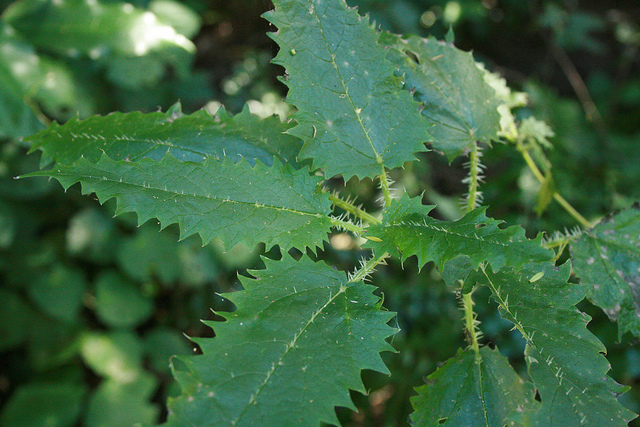Poison-envy
Bloggers: Fellows-in-conservation, Graeme Hill (writer, muso, RadioLive weekend variety wireless host and lover of NZ nature) and Forest & Bird Conservation Advocate, Nicola Vallance.
Nicola: Hot on the heels of the Forest & Bird “Bird of the Year” (BOTY) competition, the New Zealand Plant Conservation Network has launched their annual “Plant of the Year” competition. Voting closes on December 5th, so get stuck in and vote for your favourite plant or tree.
The competition has been running for seven years, and winners include the pohutakawa (twice), silver fern, and the coastal golden sand-sedge, the pingao or ‘Tane’s eyebrows’.
Like the BOTY competition, voters have traditionally gone for the ‘prettiest’ candidates (e.g. Chatham Island forget-me-not), however, the tide appears to be turning.
Currently leading the poll is one of our most stingy, prickly and nefarious plants, the tree-nettle – because as it turns out, this spiky character has same excellent qualities to it. The native tree nettle (Urtica ferox) or Ongaonga is one of those love ‘em or hate ‘em plants.
Growing more than 2m tall it is the world’s largest nettle. Covered in long, needle-sharp spines it bristles with more fire-power than a Soviet military parade and has been the nemesis of many a tramper or forest worker! You certainly know when you have brushed against ongaonga while traipsing through the bush. The hollow needle-like spines, which are found on the leaves and stems of the plant, are filled with a neurotoxin which causes a rash, irritation, pain and sometimes even damage to our nervous system, depending on the severity of the encounter (and our body’s ability to cope with the sting).
Ongaonga has caused the deaths of several dogs, horses and even an unfortunate tramper in 1961 who walked through a large patch of ongaonga with fatal consequences.
However, despite its deadly appearance, ongaonga has a huge role to play in the recovery of native butterflies – making it a popular plant indeed for those of us who love our lepidoptera. It turns out that ongaonga is the favoured food of red admiral (or kahukura) butterfly caterpillars. They also use it as a relatively safe home, rolling up the tree-nettle leaves into ‘tents’ where they are protected from potential predators.
Of course, being deadly to dogs (and the occasional person), doesn’t necessarily make it a great backyard plant if you’re keen on butterflies, but some (slightly mad) butterfly enthusiasts have thrown caution to the wind, populating parts of their garden with this impressive native. I’ll let Graeme take over here…
Graeme: I have several mature Urtica ferox plants growing in the sheltered bit down the side of my suburban house away from regular human traffic but right in the favoured path of burglars. I have been stung many times by ongaonga and it’s like about one quarter of a bee sting but it doesn’t make you sick (and we don’t kill bees because they sting).
Welts come up and the pain subsides in about half an hour. Interestingly, one can experience numbness for days afterwards in the affected area but I find that more amusing than troublesome. There seems to be no accumulated tolerance to the sting over time. I find the European nettle sting far more annoying as even just brushing against them you get thousands of milli-stings whereas with the large spines of ongaonga the stings are fewer and localised. You can count them. Also you can carefully handle the plant by avoiding the needles. You can’t do that with Euronettle.
I’d hate people to think Urtica ferox it is deadlier than it really is. As tragic as it, I suspect the tramper in ’61 must have rolled semi-naked in it. I’ve heard anecdotal evidence that dogs being stung by it try to fight back and get more and more stung in an ever escalating war between the plant and animal kingdoms, hence the deaths of some dogs. Basically, you’ll need to be stung a LOT for it do you real damage.
There is something I can say with surety that may avoid unnecessary pain. I have proven through careful scientific experiment that the proverbial assertion “Grasp the Nettle” and you won’t get stung is complete and utter rubbish.
What I have in recompense for harbouring a large shrub with military capabilities are flocks of our native Admirals. They’re delightful.
A note to growers… snails love the tree nettle and even chew away the bark. Thumb & forefinger in a leather glove does the trick.
Nicola: Well said Graeme… and while I won’t try out your “Jackass” approach to testing the mettle (or should that be ‘nettle’?) of the ongaonga, I concur. I too like a plant with a bit of character and temerity and you have to say that ongaonga has it in spades.
If you want to have you say in the “Plant of the Year” competition, head on over to the NZ Plant Conservation Network website and have your say! (http://www.nzpcn.org.nz)

